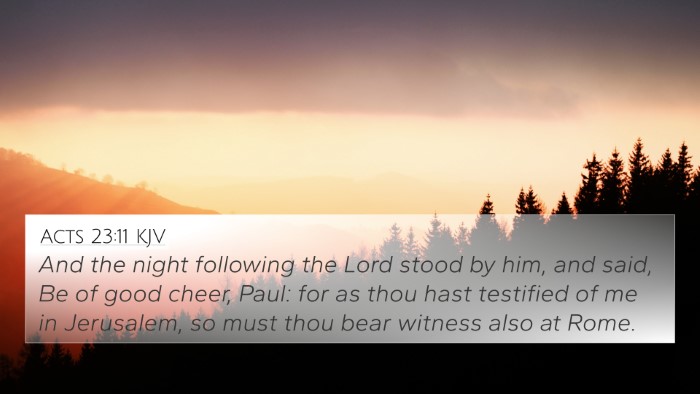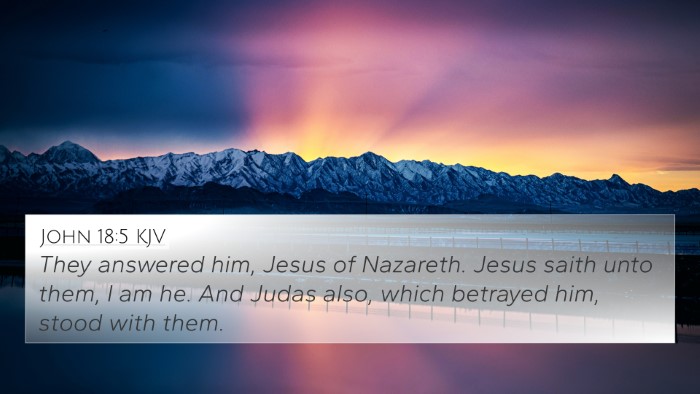Understanding John 7:44
Verse: John 7:44 - "And some of them would have taken him; but no man laid hands on him."
Contextual Overview
In John 7, we observe a critical moment in Jesus' ministry during the Feast of Tabernacles. The tension between Jesus and the religious leaders escalates as they grapple with his teachings and identity. This verse highlights the controversy and mixed reactions towards Jesus among the people.
Summarized Insights from Commentaries
-
Matthew Henry's Commentary:
This verse indicates the division among the Jewish people regarding their perception of Jesus. While some wanted to arrest him due to his bold claims and miraculous works, divine intervention prevented this action. Henry emphasizes the sovereignty of God in this context, asserting that God will protect his messengers from harm until their appointed time has come.
-
Albert Barnes' Notes:
Barnes points out that despite the desire of some to take Jesus, fear and authority played significant roles in their hesitation. The religious leaders wanted to control the narrative but were thwarted by the people's conflicting opinions, illustrating the precarious position of authority against popular sentiment.
-
Adam Clarke's Commentary:
Clarke elaborates on the phrase "no man laid hands on him," suggesting that this was not merely due to fear but also to a higher divine purpose. The reluctance shown by the captors reflects the profound impact of Jesus' teachings on the populace, as they hesitated to act against someone who commanded such respect and attention.
Bible Verse Cross-References
- Luke 4:29-30: The attempt to throw Jesus off a cliff reflects similar attempts to silence him.
- Mark 12:12: The plot against Jesus shows the continuous efforts of religious leaders to arrest him.
- Matthew 26:4: Discusses conspiracy among priests to capture Jesus covertly.
- John 10:39: Similar attempts to seize Jesus show a pattern of resistance towards his ministry.
- John 7:30: Earlier in the chapter, the desire to seize him is also expressed, highlighting ongoing tension.
- John 18:6: Reference to the arrest of Jesus where he demonstrated power even in captivity.
- Acts 4:27-28: This shows a fulfillment of prophetic words regarding opposition against the Holy One.
- John 6:66-67: Many disciples withdrew from Jesus due to hard teachings, indicating an ongoing struggle with accepting him.
- Luke 22:52: A reminder of the betrayal and arrest that would ultimately come.
- Matthew 21:46: Illustrates the disposition of the leaders as they sought a way to destroy Jesus.
Connections Between Bible Verses
The thematic richness of John 7:44 extends to various other biblical texts. Understanding this verse through cross-referencing elucidates Jesus' challenges and the overarching narrative of his ministry:
-
Divine Protection: The refusal to arrest Jesus demonstrates God's hand in his ministry, echoing Psalm 34:7 where the angel of the Lord encamps around those who fear him.
-
Public Sentiment: The divided opinions on Jesus are reflected in John 12:42-43, where many believed in him but were afraid to confess their faith.
-
Authority and Resistance: The fear of the Jewish authorities to act against Jesus resonates with John 9:22, which discusses the fear of being excommunicated for confessing faith in him.
-
The Role of Fear: The fear of man is a central theme in Proverbs 29:25, illuminating the conflict faced by those who believed in Jesus but were reluctant to act.
Conclusion
John 7:44 serves as a profound narrative point that encapsulates the struggle between faith and fear, authority and submission. The insights from key biblical commentaries, alongside relevant cross-references, enrich our understanding of this pivotal moment in Jesus' ministry. Studying these connections reveals the overarching themes of conflict, divine intervention, and the transformative power of faith in the unfolding biblical narrative.








